|
Introduction
I had planned on writing the second part
to the Dominican coral farm article this month, but have not
been in the same frame of mind to continue the "fun"
tone of the first part of that article. So, rather than force
the mindset, I have decided to engage in a two-part article
I have been planning for longer than a few years. For many
years, I have been accumulating reports of spawning in aquarium
corals. I have always felt this to be one of the ultimate
goals in captive reef husbandry, and have written many times
that our success in coral husbandry will be, to a great degree,
measured by the number and predictable nature of occurrences
of sexual reproduction. Until relatively recently, coral spawns
in aquaria were sporadic events and without any regularity
or periodicity. For the most part, this is still true, but
reports are becoming more and more frequent, and in relatively
new tanks cared for by persons without extensive experience
with reef tanks. To me, this is significant.
Finally, and perhaps most importantly,
for at least some of the spawning events being reported and
photographed in aquariums, what is being witnessed is truly
novel. First, for some events, it is reproduction of a species
that has never been witnessed, documented, or known in the
wild and serves as an important observation for general understanding
of the nature of sexual reproduction in that species. Second,
for at least a few species that have spawned in aquariums,
the method of reproduction seems to be entirely different
than what has been observed or documented in the wild. This
is, to say the least, very interesting.
I will begin this month with an overview
of sexual reproduction in corals, and continue next month
with a very long and photo-heavy documentation of coral spawning
events in aquariums, including how these spawns are either
similar or different to what is known about them in the wild.
Sexual Reproduction of Corals on Reefs
Reproduction and recruitment of corals
on coral reefs is one of the most critical processes that
allows for the persistence of coral reefs over geological
time frames. Corals reproduce both sexually and asexually.
Many corals are able to spread across reef space by asexual
means, such as fragmentation, but this results in clones of
the same colony and does not increase the diversity or gene
pool of the reef. If all corals spread by fragmentation or
other asexual means, reefs may have long ago ceased to exist,
or at least be very different, perhaps becoming victims of
inbreeding depression and a few monospecific stands competing
with each other, with one or a few likely to eventually achieve
spatial dominance.
Sexual reproduction requires the fusion
of male and female gametes (sperm and egg) that form a zygote
which grows into an embryo that develops into a free-swimming
larva called a planula. Eggs and sperm are produced in accumulations
of gastrodermal tissue (the innermost of the two coral tissue
layers) on the mesenteries called ovaries and spermaries,
respectively. Planulae are highly variable between
species, and some have the capacity to exist in the plankton
for long periods (over 100 days in some species); this allows
for long-distance dispersal and the potential ability of corals
to seed reefs far away from the parent colony. Thus, by reproducing
sexually, there is genetic diversity acquired by: 1) the contributions
of both male and female sex cells from colonies; 2) meiotic
cross-over events during the formation of those sex cells;
and 3) increases in the community genetic pool by having new
colonies recruit from outside the local community through
dispersal of planulae. This has practical implications in
that reefs which might be lost to natural or man-made catastrophes
will still persist in that the gene pool of colonies might
exist far away, and that in time, the gene pool of reefs far
away can reseed the reef that has been destroyed.
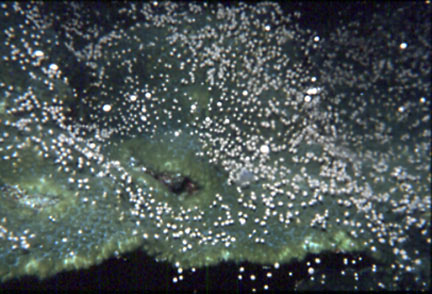 |
The "Sexual Orientation" of Corals
No, this is not a joke that demands political
correctness. Corals can be divided into two major groups in
regard to their sexual nature.
The first group is divided into two subgroups
depending on whether or not a colony produces separate sperm
and eggs. Gonochoric (also known as dioecious) species,
or those in which colonies are either male (producing sperm)
or female (producing eggs), comprise about 25 percent of corals
studied. The remaining 75 percent are considered hermaphroditic,
where a single colony produces both sperm and eggs. The term
hermaphrodite is interesting; it comes from Greek mythology.
Hermes was the messenger of the gods, and Aphrodite was the
goddess of beauty. Hence, the male sperm "messenger"
delivers his package to the female egg "beauty goddess."
Six species, Agarcia agaracites, A. humilis,
Galaxea fascicularis, G. astreata, Caryophyllia
ambrosia, and Porites astreoides, have been reported
as having the potential to be either gonochoric or hermaphroditic.
Hermaphroditism can be further subdivided
into three other groups. In the first, simultaneous hermaphrodites,
sperm and eggs are produced at the same time. Other species
are functional male colonies first, and then develop into
functional female colonies. This is called protandry.
On the other hand, some species are functional female colonies
first, and then develop into functional male colonies. This
is called protogyny. Species that are either protandrous
or protogynous are called sequential hermaphrodites.
The majority of hermaphroditic corals are simultaneous hermaphrodites.
The second group is divided into two subgroups
depending on how gametes come into contact with each other.
Broadcast spawners release eggs and sperm into the
water column for external fertilization and development. Brooders
have eggs fertilized internally with development of the planulae
within the polyps. The majority of corals studied are broadcast
spawners (approximately 85 percent), with the remaining 15
percent being brooders. Until recent times, it was believed
that most corals were "viviparous," or brooders.
Notably contrary to most animals, some coral species, such
as Pocillopora damicornis, are known to exhibit both
brooding and broadcast spawning reproductive methods in different
locations. It has also been proposed that this may be a valid
reason to examine such populations to see if they are really
separate species or subspecies.
The Importance of Being Different
The variations in sexual reproduction
in corals are theoretically significant in numerous ways.
To better understand the importance of these traits, each
method has various characteristics that can be generally applied
to the species or communities utilizing them. In terms of
hermaphroditic and gonochoric species, hermaphroditism is
favorable in small populations so that there an increased
likelihood of having successful fertilization. Even one simultaneous
hermaphrodite can produce many new planulae and still not
suffer from significant inbreeding because of crossing-over
events during meiosis. Each polyp in a colony undergoes separate
cross-over events in the production of gametes, and so a colony
of several thousand, or even million, polyps can theoretically
produce half that number of viable, genetically different
colonies all by itself.
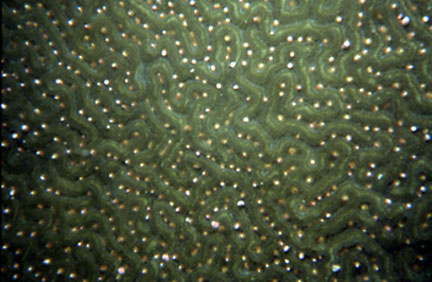 |
This feat has several important implications.
First, it makes it apparent how effective corals can be in
terms of keeping reefs populated and is certainly a major
reason for their success over eons of time. Second, it is
testimony to the advantages of both hermaphroditism and a
colonial lifestyle. Third, it should be apparent how advantageous
it could be in terms of producing all the corals ever required
for the aquarium trade by having sexual reproduction occur
and a means to settle and rear the recruits. Quite literally,
one or two colonies of a species could provide for every coral
ever demanded by the aquarium trade forever. In other words,
were a person so inclined, a thousand coral colonies of different
species could be the sum impact that the aquarium coral trade
has on reefs from now on and still provide the same diversity
of species available and be continuously available. In contrast,
some one million coral colonies will be taken from coral reefs
this year to supply just the United States aquarium trade,
most of which will not survive and, of the survivors, most
of which will never reproduce.
The major difference in the life history
of corals is not between gonochorism and hermaphroditism,
however, it is in the differences between brooding and broadcast
spawning. These differences include the transfer of zooxanthellae
to the larvae, larval dispersal times, dispersal patterns,
genetic variability and rates of speciation and evolution.
Brooders produce planula larvae that, when
released, are immediately competent to settle and metamorphose
into juveniles. They are generally larger than the larvae
produced by non-brooders, and contain a "starter culture"
of zooxanthellae. As such, they tend to not disperse for long
or very far, and the larvae of brooders tend to settle and
metamorphose usually close to the parent or within the same
local community. It is interesting that although brooded planulae
are potentially able to disperse farther because of the zooxanthellae
providing them with energy, they generally do not do so. Not
all brooders develop the planulae within the gastric cavity
of the polyp, either. At least some species brood the larvae
on the surface of the colony, underneath the mucus; soft corals,
such as Clavularia and Briareum (star polyps)
are known to engage in surface brooding.
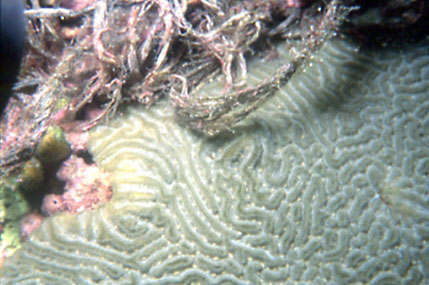 |
Broadcast spawners, in contrast, fertilize
externally, and the planulae develop in the water column.
The length of time it takes for them to develop competence
to settle depends on the species, and can also depend on environmental
cues. This time can vary between hours to weeks. Because sperm
and egg are separate and fertilize external to the parent
polyp, zooxanthellae must be acquired from the water column.
Depending on the time of zooxanthellae acquisition, and the
specific characteristics of a species planulae, the pelagic
phase for broadcast spawning corals prior to becoming competent
to settle can last from less than a day to over 120 days.
Broadcast spawning corals tend to settle and metamorphose
away from local communities, but are thought to usually settle
no farther than nearby communities (with obvious potential
to go farther). However, this aspect has rarely been even
attempted to be measured as it is very difficult to track
individual planulae in a pelagic state.
The Magic of Being a "Synchronous, Simultaneous,
Hermaphroditic, Broadcast Spawning Colonial Coral Species."
What a mouthful of verbiage! As will be
discussed in more detail below, broadcast spawners often release
en masse, otherwise known as synchronous mass spawning;
that is, within a period of hours to days, many species release
their gametes synchronously. This is called swamping,
and is thought to maximize the number of successful fertilizations
be reducing he number of eggs that predators could consume
by overloading their abilities to consume them all. Most simultaneous
coral hermaphrodites do not release eggs and sperm separately,
but release them in egg-sperm packets, with a few to
several hundred eggs surrounding (or surrounded by) a packet
of sperm. After several minutes to hours, and depending sometimes
on environmental cues, the packets rupture and fertilization
can take place. This is important, because eggs are positively
buoyant and will float to the surface, and they have fairly
long competency periods in seawater. Sperm, however, are rapidly
diffused in water, are not buoyant, and have a short competency
period in seawater. Were eggs and sperm not released exactly
at the same time, and if fertilization did not take place
in the immediate vicinity of the colony, a much lower fertilization
success rate would likely occur. Because both eggs and egg-sperm
packets float, they form slicks on the water surface that
can drift for many days and many miles. As this mass of gametes
drifts, and as the egg-sperm packets rupture, there is a much
greater chance of fertilization taking place, and a much greater
chance of genetic mixing. Furthermore, because planulae from
broadcast spawners can disperse farther, they tend to persist
longer over evolutionary time frames. This probably accounts
for the fact that most corals are synchronous, simultaneous
hermaphroditic broadcast spawners. The success rate for fertilization
and maintenance of the species gene pool and metapopulation
is the highest.
Synchronicity
Much attention has been given to the factors
that result in the almost mystical synchronous mass spawning
that occurs on coral reefs around the world. I must preface
by saying a few things: First, not all corals, nor all coral
reefs, have mass spawning events; Second, not all corals,
nor all coral reefs, spawn at the same time; Third, not all
coral or coral reefs seem to depend on the same cues for mass
spawning. The first mass spawning event was not even officially
"discovered" until the early 1980's! Since then,
and with more and more divers and researchers in the waters,
it is becoming clear that many, if not most, corals on reefs
participate in these amazing events. For anyone interested,
the video, Coral Sea Dreaming, has outstanding footage
of mass spawning on the Great Barrier Reef that involves corals,
sea stars, sea cucumbers, and polychaetes in an underwater
display that is too beautiful to even describe.
As prefaced above, and perhaps to the chagrin
of many aquarists, the exact cues that are involved in mass
spawning are not fully understood. Many aquarists erroneously
believe that they will trigger mass spawning in their aquaria
by putting a "moonlight" bulb above their tanks.
Unfortunately, I fear this will not do much. What follows
below is a summary of what seems to be the general sequence
of events required for corals to mature and release their
gametes.
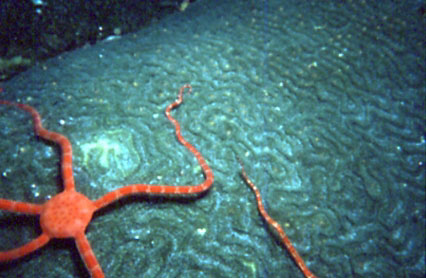 |
Corals, like other organisms, take time
to reach reproductive maturity. Unlike humans, there is no
set period before and during "puberty." For some
species, age seems to be the determining factor; for example,
Xenia species have been found to become reproductively
mature at about one year of age while female colonies of Sarcophyton
spp. may be ten to twelve years old before they mature. For
other species, it appears that a set size must be reached
before the colony becomes reproductively mature. For some
corals, they must have a surface area that exceeds a certain
critical size, while for others it may be branch length. For
still other species, it appears that polyp density may be
the determining factor for sexual maturity; that is, once
a certain number of polyps have been formed, the colony can
begin producing gametes irrespective of the surface area of
the colony or the length of the branches - processes that
become confounded by aspects of growth such as calcification
rates, growth forms, and skeletal density.
It is worth mentioning that though a colony
may be of a correct age, size, or polyp density, that there
is no guarantee that the colony is or will become fecund
(capable of producing offspring). Production of gametes requires
a large amount of energy, and a spawning coral may release
25-75% of its biomass during spawning. Thus, production of
gametes requires a significant surplus of energy beyond that
required for metabolism and growth. During gametogenesis,
it has been found that many corals may also stop feeding,
so that excess must be acquired prior to commencement of gamete
formation, and from that acquired by photosynthesis in zooxanthellate
corals. However, gametes are protein rich, and so photosynthesis
may be more important for simply maintaining the coral during
half the year while it is producing ripe gonads, rather than
for any major contribution to the gonads directly. Furthermore,
any stress, injury, or partial colony mortality may either
sap enough energy such that gamete production is halted and
gametes resorbed, or it may drop the colony to a size or polyp
density below the minimum required for reproduction. In some
cases, a colony may be partially fecund, with large expansive
healthy areas of the colony releasing gametes with less healthy
areas not having fecund polyps.
It is thought that temperature plays the
prominent role in signaling for gonad and gamete production.
Generally, as temperatures begin to warm, gonads begin to
ripen. This process may take half a year or more, and areas
with variable or very stable year-round water temperatures
present somewhat of a mystery. It is also notable that the
winter is a time of reduced growth in corals and early spring
often a time of increased plankton abundance. Perhaps corals
use this time to amass the nitrogen-rich food required for
the time of gonad production occurring during the summer.
This maturation process is typical for most reef corals in
that the majority seem to have annual spawning events. However,
many reefs and corals may spawn biannually or semiannually,
and some corals may also spawn on a monthly cycle. This clearly
indicates that more must be learned about spawning behavior
in corals. On the other hand, anomalous years with regard
to temperature often result in spawning events that do not
take place on the expected month, or they may not occur at
all that year. This lends some additional credence to the
role of water temperature in sexual maturation of reef corals.
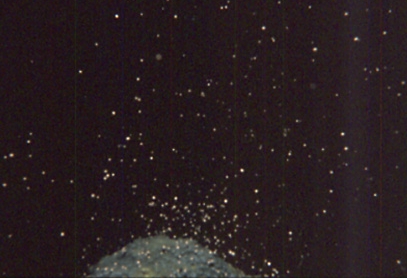 |
As water temperatures reach their annual
maxima, the gametes are produced by the now mature ovaries
and spermaries and reside within the corals until a triggering
event causes their release. As indicated above, spawning typically
takes place on the month of, or the month after, the warmest
average monthly water temperature in annual mass spawnings.
However, the "fame" of mass spawning events is related
to lunar periodicity. It is thought that the lunar phase provides
the cues for the timing of mass gamete release. In other words,
during the month of the hottest water temperature, the day
and time of the release depends on the phase of the moon.
It was thought, based on early reports of limited mass spawning
sites, that spawning occurred a night or two after the full
moon. However, with more reports and documentations, spawning
may be highly correlated to a lunar phase, but varies significantly
across locations. It makes most sense that release should
take place when the moon is new and the waters are darkest
to minimize loss of eggs by predation. However, I am not aware
that any real patterns have emerged as to the exact lunar
phase that incorporates any real majority of reefs. Unfortunately
for aquarists whose corals likely came from many different
reefs, the use of a moonlight, even if cyclically dimmed,
will probably not have much of an effect in triggering mass
spawns in a tank, even if the tank has been temperature controlled
for seasonal cycles, and even if the corals are sexually mature
and fecund.
Furthermore, chemical cues are involved
in spawning and mass spawning events, although the exact cues
and factors are only beginning to be discovered. Sperm attractants
have been isolated in a number of species, and such water
borne signals may be important in triggering spawning in other
species. In addition, a number of other factors have been
proposed or determined to be contributing to, or being responsible
for, various aspects of spawning behavior. A list of the many
factors involved in coral spawning is found in Table 1.
|
Annual
periodicity
|
Seasonal
periodicity
|
Diurnal
periodicity
|
|
Lunar
periodicity
|
Chemical
signaling
|
Water
temperature
|
|
Tidal
influences
|
Latitudinal
differences
|
Species
genotype
|
|
Nutritional
factors
|
Light
availability
|
Moonlight
|
|
Colony
size
|
Polyp
density
|
Colony
age
|
|
Colony
health
|
Water
quality
|
Salinity
|
|
Day
length
|
Community
structure
|
Water
motion
|
|
Gravitational
fields
|
Predator
abundance
|
Night
length
|
|
Table
1. Factors proposed or determined to contribute
to sexual maturity in reef corals.
|
In particular, one area in which I believe
deserves more study was proposed as a result of annual and
synchronized mass spawning in corals from the Red Sea where
temperature variation over the year was highly variable. Coral
polyps are unable to detect light levels, and it is the zooxanthellae
that are able to detect light. However, there is considerable
question as to the ability of these intracellular algae to
detect changes in photon flux density that is on the scale
of the irradiance levels of moonlight, even on a full moon.
Zooxanthellae reside within coral tissue of varying thickness
and opacity, under a variably thick mucus layer containing
variable levels of other photosynthetic microbes and receive
a mere fraction of the light reaching the coral surface. Depth,
turbidity, haze in the air, clouds, over flights of Israeli
aircraft, or any number of exceptionally minor events could
change the irradiance levels of moonlight to an extent that
in all likelihood makes it almost impossible to even remotely
consider the possibility that zooxanthellae or corals could
detect whether or not a particular night is a full moon or
a new moon. Furthermore, spawning events will often, though
not always, happen irrespective of how cloudy or hazy the
night of the spawn might be, or how turbid or deep the water,
or how shaded a colony might be by another. For an organism
to have a biological response to light requires a photoreceptor
and an immediate and quantifiable response for its nervous
system. In corals the only photoreceptors are the zooxanthellae,
and their response, the production of photosynthetically-produced
chemicals, is neither specific enough nor quantitative enough
for such a use.
 |
However, and as the study mentioned above
suggested, there is one factor that will not vary annually
and involved light levels and periods which would be detectable
by zooxanthellae - day length or night length. Terrestrial
plants are triggered to flower, fruit or produce fall colors
based on whether they are long day (short night), intermediate
day, or short day (long night) plants. In other words, when
day length or night length reaches a critical value, phytochromes
trigger signal transduction processes that cause hormones
and other signals to be produced that, in turn, cause behavioral
and biochemical processes. It is my feeling that future research
will find that zooxanthellae are responsible for triggering
the coral polyp's gamete release by producing chemical signals
based on day or night length. However, there is still a question
remaining. There are day-neutral plants that do not respond
to changes in day or night length, and they are primarily
tropical ones where there is little or no variation in day
length. They must depend on other proximate cues that may
vary between species. However, this likely explains the variations
in timings of mass spawning events on various reefs, why moonlight
levels have not been found to have a strong correlation across
reefs, and perhaps, most interestingly, why equatorial reefs
seem to have less predictable (or semi-annual) mass spawning
events than those at higher latitudes. To my knowledge, this
idea is not being pursued in the coral research community
but deserves investigation.
The Timing of Gamete Release
In general, corals release their gametes
at night, although there are many examples of daytime release
and some, such as Fungia species, may spawn day and
night. Most spawning takes place over a period of minutes
to hours, although release may be spread out over several
consecutive nights. In rare cases, such as with Hydnophora
exesa, spawning may be spaced out over several weeks.
The timing of release is usually consistent from year to year;
so much so that the spawning times of coral species can be
predicted within a matter of minutes. For example, in the
Flower Gardens, Diploria spawns between 9:00 and 10:00
p.m. and Montastraea spawns fifteen to thirty minutes
later, followed an hour later by Stephanocoenia. This
predictability in the degree of timing by at least the initial
coral species is absolutely astonishing, although species
following may be reacting to chemical cues.
Settlement and Metamorphosis - Only the Beginning
Upon successful formation of competent
planulae, either by brooding or by fertilization in the water
column of broadcast spawning corals, there are events that
determine if and where the planulae will settle on the reef,
and then metamorphose into a juvenile coral polyp. To date,
a number of factors have been proposed to explain the environmental
cues required to initiate the planulae descending from the
water column to settle on substrate. Among the most studied
are rugosity (roughness) of the substrate, depth, light, biofilms
produced by bacteria and other microorganisms, and coralline
algae. Current thought and research suggests that coralline
algae are by far the most important factor involved. Specific
chemical signals have been isolated from coralline algae that
induce settlement in coral and other invertebrate larvae with
controls for depth, light, and biofilms indicating they play
secondary, if any roles, in the event. The variations reported
for the other factors are easily explained in that various
coralline algae produce different chemical signals, are variable
in the depths they inhabit, have different associated biofilms,
and may grow preferentially on substrates of varying rugosity.
 |
Once settled on coralline algae, planulae
tend to settle in protected areas and crawl outwards into
the light over a varying period of time that probably reflects
a degree of competence in the metamorphosis process that ensures
the newly settled spat are in an optimal position for survival
and reflects their ability begin calcifying, as well as to
have access to food, light, and space. Some coral species,
such as Pocillopora damicornis, produce larvae that
can and do release from their settlement site if conditions
are not optimal and resettle at a later time (if available
substrate exists!), indicating that the settlement and metamorphosis
processes are both dynamic and not inflexible. Following settlement
and metamorphosis, a tiny single coral polyp faces a very
uncertain period where mortality rates are extremely high.
However, if successful, this tiny almost unrecognizable polyp
may, over the course of years to centuries, become a coral
colony capable by itself of reseeding countless other coral
reefs perhaps thousands of miles away - most remarkable life
history story and biological adventure.
In the next column, the marvel of nature
described in this article will be furthered in describing
even more remarkable events…coral spawning in captive
reef aquaria.
Link to
Part
II
|

